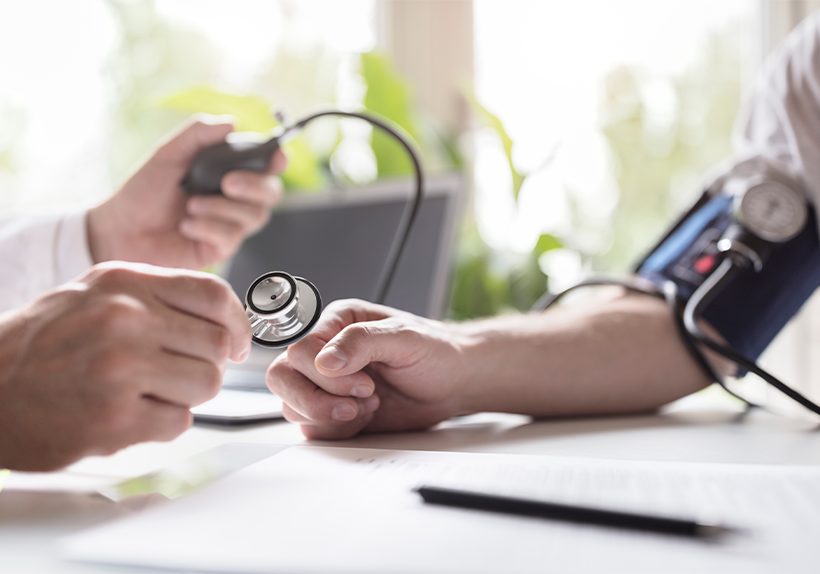The Center for Disease and Control reports nearly 68 million people have high blood pressure (HBP), also called hypertension. Being labeled “the silent killer” and such a common condition, there is a need to understand what high blood pressure means, who is at risk, and how it can be prevented and controlled.
What is the definition of high blood pressure?
High blood pressure is when the force of your blood pushing against the walls of your blood vessels is consistently too high. Each time your heart beats, it forces blood into the arteries. When the heart is at rest between beats, the amount of pressure falls.
How do you read blood pressure?
Blood pressure is read with an arm or wrist cuff with the most accurate reading captured by manual arm cuff and stethoscope. Two numbers are produced with each reading, with very significant meanings.
Systolic (the top number)- blood is pumping out of the heart
- Tells how much pressure your blood is exerting against your artery walls when the heart beats.
Diastolic (the bottom number)- between heart beats when the heart is filling with blood
- Indicates how much pressure your blood is exerting against your artery walls while the heart is resting between beats.
What are the five main blood pressure ranges?
According to the American Heart Association the five main blood pressure ranges are as follows:
- Normal 120/80 mm Hg
- Elevated 120-130/80-90 mm Hg
- High Blood Pressure (Stage 1) 140-159/90-99 mm Hg
- High Blood Pressure (Stage 2) 160+/100+ mm Hg
- Hypertensive Crisis (Emergency Stage) 180+/110+ mm Hg
The abbreviation mm Hg means millimeters of mercury and is the standard unit of measurement for pressure.
What are the signs & symptoms of hypertension?
This disease is referred to as “the silent killer” because most of the time, there are no signs or symptoms. Most people do not realize they are suffering from HBP until there is a serious health problem. A diagnoses is determined over a period of time by a doctor who takes two or more readings of your blood pressure at several medical appointments.
What lifestyle should one maintain/change according to each range?
Depending on where your BP range falls, there are mild changes that can be made to remain healthy, up to drastic changes such as medication and emergency assistance.
- Normal– continue to follow a well-balanced, heart-healthy diet with regular exercise
- Elevated– control your condition with diet and exercise to avoid developing hypertension
- High Blood Pressure (Stage 1)- above lifestyle changes as well as medication to prevent heart attack or stroke
- High Blood Pressure (Stage 2)- additional lifestyle changes and blood pressure medication
- Hypertensive Crisis (Emergency State)- Call 911
Who is at risk for developing HBP?
Primary risk factors that can lead to developing hypertension are the following:
- Age
- Family History & Genetics
- Lifestyle Habits
- Medicines
- Race or Ethnicity
- Sex
- Social Economic Factors
- Other Medical Conditions
The National Heart, Lung and Blood Institute lists the above risk factors for developing HBP. Blood pressure increases with age as artery walls harden and thicken. Predisposition is often determined by the DNA make up in the womb due to genetic factors and a developed sensitivity to salt. Lifestyle habits is the most controllable factor contributing to hypertension. Poor diet, too much alcohol or caffeine, use of illegal drugs, and not sleeping enough can lead to high BP.
Medications contributing to HBP include antidepressants, decongestants, hormonal birth control pills, and non-steroidal anti-inflammatory drugs (NSAIDs) such as aspirin or ibuprofen. A diagnosis is more commonly tied to the African American population and affects females more than males. Research has shown that income, education level, where you live and type of job may also contribute to HBP. Other medical conditions include: certain tumors, chronic kidney disease, metabolic syndrome, obesity, sleep apnea, and thyroid problems.
Secondary risk factors include heart disease, stroke, and congestive heart failure.
What are the health threats of hypertension?
- Stroke
- Vision Loss
- Heart Attack
- Kidney Disease/Failure
- Heart Failure
- Sexual Dysfunction
- Vascular Dementia
Heart attack, failure or stroke is caused by hardening and thickening of the arteries due to hypertension. Vision loss is caused by damage to the delicate vessels that supply blood to the eyes while kidney disease is a result of the arteries around the kidneys becoming narrow, weak and damaged. Sexual dysfunction can be a consequence of the use of antihypertensive medications to control the disease and vascular dementia is linked to narrowing of the blood vessels in the brain.
How can HBP be prevented and controlled?
Diet and exercise are the main ways to control blood pressure. The Mayo Clinic provides a list of lifestyle changes that can be made to lower your blood pressure and keep it down:
- Lose extra pounds and watch your waistline
- Exercise regularly
- Eat a healthy diet.
- Reduce sodium in your diet
- Limit the amount of alcohol you drink
- Quit smoking
- Cut back on caffeine
- Reduce your stress
- Monitor your blood pressure at home and see your doctor regularly
- Get support
Everyone over the age of three should have their blood pressure checked once a year.
Blood pressure often climbs as weight increases. Losing weight is one of the most effective lifestyle changes in controlling blood pressure. It is advised to exercise 30 minutes per day, most days of the week, such as walking, jogging, cycling, swimming or dancing. Eating a healthy diet rich in whole grains, fruits, vegetables and low-fat dairy help keep blood pressure down by passing on saturated fats and cholesterol.
Decreasing salt also lowers blood pressure. Just 1 teaspoon of salt has 2,300 mg of sodium and a good substitution for flavoring food is herbs and spices. Controlling alcohol intake and quitting smoking are additional ways to help return blood pressure to normal. While drinking caffeine can increase BP by 10 mm Hg, cutting back can lower blood pressure as well as practicing ways to control stress and monitoring BP at home. You can also seek the support of friends, family, and join a support group.
Receiving a diagnosis of high blood pressure must be confirmed by a healthcare professional.
American Online Benefits Group offers plans that include visits to primary care physicians to measure and monitor your blood pressure. Discount blood pressure medications are also available through our SimpleScripts Rx membership. Please contact our agent or member services to receive more information at 214-389-9072.




